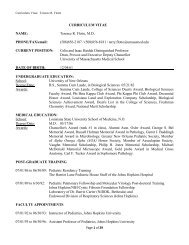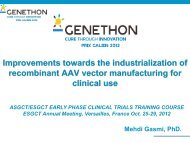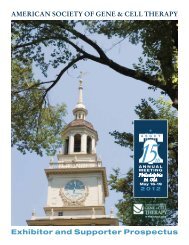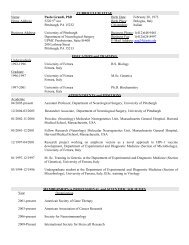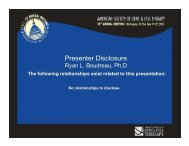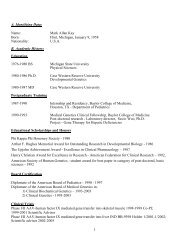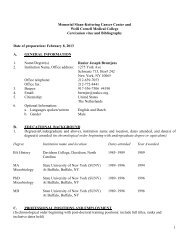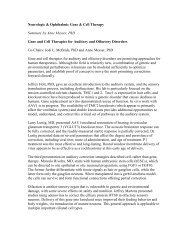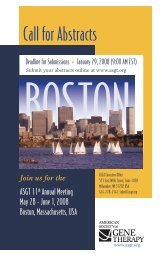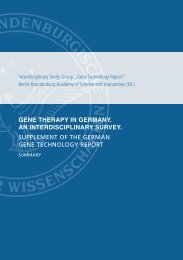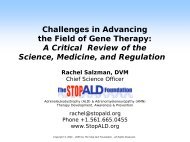FINAL PROGRAM - American Society of Gene & Cell Therapy
FINAL PROGRAM - American Society of Gene & Cell Therapy
FINAL PROGRAM - American Society of Gene & Cell Therapy
- No tags were found...
Create successful ePaper yourself
Turn your PDF publications into a flip-book with our unique Google optimized e-Paper software.
13 th AnnUAL MEETing | Washington, DC USA May 19-22, 2010 37Program ScheduleEducation Session 1305:30 pm - 7:00 pmRoom: Marriott Ballroom Salon 1Emerging Field Review: Progress Towards Using ES/iPS <strong>Cell</strong>s for Regenerative MedicineThe excitement over embryonic stem cells and induced pluripotent stem cells is that they are a potential source <strong>of</strong> cells for tissues in which tissue specific stem cells haveeither not been identified, not easily isolated, or not easily expanded. That pluripotent stem cells can now be generated from somatic cells, without the destruction <strong>of</strong> anembryo, removes a major ethical barrier to their use. Nonetheless, a continued barrier to the translation <strong>of</strong> pluripotent stem cells to clinical use is to expand and differentiatethem in both a safe and quantitatively sufficient manner that they can be used for tissue specific regenerative medicine applications. This educational session willfocus on the progress that has been made in generating sufficient numbers <strong>of</strong> safe tissue specific cells towards this end.Wednesday, May 19 thChairMatthew H. Porteus, MD, PhDSpeakersRonald D.G. McKay, PhDElias T. Zambidis, MD, PhD<strong>Gene</strong>ration <strong>of</strong> HSC and Red Blood <strong>Cell</strong>s from Normal and Hemoglobinopathic iPSCEvan Y. Snyder, MD, PhD, FAAPCross-Talk and Developmental Programs in Stem <strong>Cell</strong> Biology – A Key to Regenerative MedicineEducation Session 1315:30 pm - 7:00 pmRoom: Maryland SuiteEmerging Field Review: Targeted IntegrationUncontrolled insertion <strong>of</strong> foreign DNA into the human genome may have deleterious consequences, and is a serious safety concern in the clinical application <strong>of</strong> genetherapy. New molecular tools are being developed to target transgene integration to specific sites in the genome and increase the frequency <strong>of</strong> homologous recombination,with the purpose <strong>of</strong> achieving gene correction or replacement in the original genomic environment. These advances include the use <strong>of</strong> Zn-finger nucleases and homingendonucleases, and the delivery <strong>of</strong> homologous recombination cassettes by viral and non-viral vectors. They will be discussed in the context <strong>of</strong> developing better and safergene transfer technology.ChairFulvio Mavilio, PhDSpeakersJ. Keith Joung, MD PhDEngineered Zinc Finger Nucleases for Targeted Genome ModificationEngineered zinc finger nucleases (ZFNs) form the basis <strong>of</strong> a broadly applicable approach for inducing targeted alterations with high efficiency in human and other mammaliancells. This session will provide an introduction to this important technology by: (1) discussing methods for engineering customized ZFNs including OligomerizedPool ENgineering (OPEN) and modular assembly; (2) describing how ZFNs have been used to introduce knockout mutations, insertions and other specific alterations vianon-homologous end-joining and homologous recombination; and (3) considering future experiments and goals for advancing the use <strong>of</strong> ZFNs for therapeutic and researchapplications.Andrew M. Scharenberg, MDHoming Endonucleases as Tools for Targeted IntegrationThe idiosyncratic nature <strong>of</strong> side effects resulting from random integration <strong>of</strong> promoter/gene cassettes in the context <strong>of</strong> viral vector-mediated gene therapy has led toincreasing interest in targeted integration as an alternative approach. A promising methodology for targeted integration involves application <strong>of</strong> rare cleaving nucleases toinduce site specific homologous recombination. Homing endonucleases are an important class <strong>of</strong> rare cutting nucleases whose potential applications in targeted integrationare only now emerging. Homing endonuclease biology, properties, engineering, and applications in targeted integration will be reviewed.



